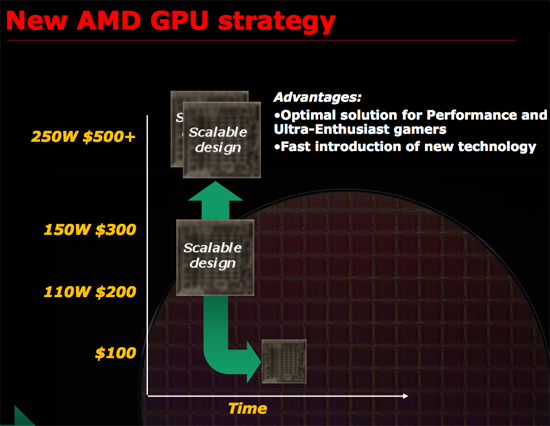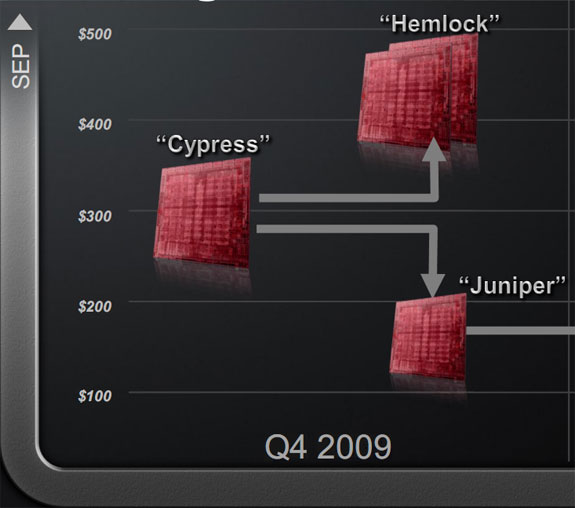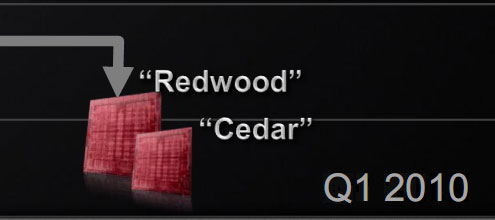AMD's Radeon HD 5870: Bringing About the Next Generation Of GPUs
by Ryan Smith on September 23, 2009 9:00 AM EST- Posted in
- GPUs
Meet the Rest of the Evergreen Family
Somewhere on the way to Cypress, AMD’s small die strategy got slightly off-track.

AMD’s small-die strategy for RV770
Cypress is 334mm2, compared to 260mm2 for RV770. In that space they can pack 2.15 billion transistors, versus 956 million on the RV770, and come out at a load power of 188W versus 160W on the RV770. AMD called 256mm2 their sweet spot for the small die strategy, and Cypress missed that sweet spot.
The cost of missing the sweet spot is that by missing the size, they’re missing the price. The Cypress cards are $379 and $259, compared to $299 and $199 that the original small die strategy dictated. This has resulted in a hole in the Evergreen family, which is why we’re going to see one more member than usual.

As Cypress is the base chip, there are 4 designs and 3 different chips that will be derived from it. Above Cypress is Hemlock, which will be the requisite X2 part using a pair of Cypress cores. Hemlock is going to be interesting to watch not just for its performance, but because by missing their sweet spot, AMD is running a bit hot. A literal pair of 5870s is 376W, which is well over the 300W limit of a 6-pin + 8-pin power configuration. AMD saves some power in a single card (which is how they got the 4870 under the limit) but it likely won’t be enough. We’ll be keeping an eye on this matter to see what AMD ends up doing to get Hemlock out the door at the right power load. As scheduled we should see Hemlock before the end of the year, although given the supply problems for Cypress that we mentioned earlier, it’s going to be close.
The “new” member of the Evergreen family is Juniper, a part born out of the fact that Cypress was too big. Juniper is the part that’s going to let AMD compete in the <$200 category that the 4850 was launched in. It’s going to be a cut-down version of Cypress, and we know from AMD’s simulation testing that it’s going to be a 14 SIMD part. We would wager that it’s going to lose some ROPs too. As AMD does not believe they’re particularly bandwidth limited at this time with GDDR5, we wouldn’t be surprised to see a smaller bus too (perhaps 192bit?). Juniper based cards are expected in the November timeframe.

Finally at the bottom we have Redwood and Cedar, the Evergreen family’s compliments to RV710 and RV730. These will be the low-end parts derived from Cypress, and will launch in Q1 of 2010. All told, AMD will be launching 4 chips in less than 6 months, giving them a top-to-bottom range of DX11 parts. The launch of 4 chips in such a short time frame is something their engineering staff is very proud of.










327 Comments
View All Comments
poohbear - Wednesday, September 23, 2009 - link
is it just me or is anyone else disappointed? next gen cards used to double the performance of previous gen cards, this card beats em by a measly 30-40%. *sigh* times change i guess.AznBoi36 - Wednesday, September 23, 2009 - link
It's just you.The next generations never doubled in performance. Rather they offered a bump in framerates (15-40%) along with better texture filtering, AA, AF etc...
I'd rather my games look AMAZING at 60fps rather than crappy graphics at 100fps.
SiliconDoc - Monday, September 28, 2009 - link
Golly, another red rooster lie, they just NEVER stop.Let's take it right from this site, so your whining about it being nv zone or fudzilla or whatever shows ati is a failure in the very terms claimed is not your next, dishonest move.
---
NVIDIA w/ GT200 spanks their prior generation by 60.96% !
That's nearly 61% average increase at HIGHEST RESOLUTION and HIGHEST AA AF settings, and it right here @ AT - LOL -
- and they matched the clock settings JUST TO BE OVERTLY UNFAIR ! ROFLMAO AND NVIDIA'S NEXT GEN LEAP STILL BEAT THE CRAP OUT OF THIS LOUSY ati 5870 EPIC FAIL !
http://www.anandtech.com/video/showdoc.aspx?i=3334...">http://www.anandtech.com/video/showdoc.aspx?i=3334...
--
roflmao - that 426.70/7 = 60.96 % INCREASE FROM THE LAST GEN AT THE SAME SPEEDS, MATCHED FOR MAKING CERTAIN IT WOULD BE AS LOW AS POSSIBLE ! ROFLMAO NICE TRY BUT NVIDIA KICKED BUTT !
---
Sorry, the "usual" is not 15-30% - lol
---
NVIDIA's last usual was !!!!!!!!!!!! 60.69% INCREASE AT HIGHEST SETTINGS !
-
Now, once again, please, no lying.
piroroadkill - Wednesday, September 23, 2009 - link
No, it's definitely just youGriswold - Wednesday, September 23, 2009 - link
Its just you. Go buy a clue.ET - Wednesday, September 23, 2009 - link
Should probably be removed...Nice article. The 5870 doesn't really impress. It's the price of two 4890 cards, so for rendering power that's probably the way to go. I'll be looking forward to the 5850 reviews.
Zingam - Wednesday, September 23, 2009 - link
Good but as seen it doesn't play Crysis once again... :DWe shall wait for 8Gb RAM DDR 7, 16 nm Graphics card to play this damned game!
BoFox - Wednesday, September 23, 2009 - link
Great article!Re: Shader Aliasing nowhere to be found in DX9 games--
Shader aliasing is present all over the Unreal3 engine games (UT3, Bioshock, Batman, R6:Vegas, Mass Effect, etc..). I can imagine where SSAA would be extremely useful in those games.
Also, I cannot help but wonder if SSAA would work in games that use deferred shading instead of allowing MSAA to work (examples: Dead Space, STALKER, Wanted, Bionic Commando, etc..), if ATI would implement brute-force SSAA support in the drivers for those games in particular.
I am amazed at the perfectly circular AF method, but would have liked to see 32x AF in addition. With 32x AF, we'd probably be seeing more of a difference. If we're awed by seeing 16x AA or 24x CFAA, then why not 32x AF also (given that the increase from 8 to 16x AF only costs like 1% performance hit)?
Why did ATI make the card so long? It's even longer than a GTX 295 or a 4870X2. I am completely baffled at this. It only has 8 memory chips, uses a 256-bit bus, unlike a more complex 512-bit bus and 16 chips found on a much, much shorter HD2900XT. There seems to be so much space wasted on the end of the PCB. Perhaps some of the vendors will develop non-reference PCB's that are a couple inches shorter real soon. It could be that ATI rushed out the design (hence the extremely long PCB draft design), or that ATI deliberately did this to allow 3rd-party vendors to make far more attractive designs that will keep us interested in the 5870 right around the time of GT300 release.
Regarding the memory bandwidth bottleneck, I completely agree with you that it certainly seems to be a severe bottleneck (although not too severe that it only performs 33% better than a HD4890). A 5870 has exactly 2x the specifications of a 4890, yet it generally performs slower than a 4870X2, let alone dual-4890 in Xfire. A 4870 is slower than a 4890 to begin with, and is dependent on Crossfire.
Overall, ATI is correct in saying that a 5870 is generally 60% faster than a 4870 in current games, but theoretically, a 5870 should be exactly 100% faster than a 4890. Only if ATI could have used 512-bit memory bandwidth with GDDR5 chips (even if it requires the use of a 1024-bit ringbus) would the total memory bandwidth be doubled. The performance would have been at least as good as two 4890's in crossfire, and also at least as good as a GTX295.
I am guessing that ATI wants to roll out the 5870X2 as soon as possible and realized that doing it with a 512-bit bus would take up too much time/resources/cost, etc.. and that it's better to just beat NV to the punch a few months in advance. Perhaps ATI will do a 5970 card with 512-bit memory a few months after a 5870X2 is released, to give GT300 cards a run for its money? Perhaps it is to "pacify" Nvidia's strategy with its upcoming next-gen that carry great promises with a completely revamped architecture and 512 shaders, so that NV does not see the need to make its GT300 exceed the 5870 by far too much? Then ATI would be able to counter right afterwards without having to resort to making a much bigger chip?
Speculation.. speculation...
Lakku - Wednesday, September 23, 2009 - link
Read some of the other 5780 articles that cover SSAA image quality. It actually makes most modern games look worse, but that is through no fault of ATi, just the nature of the SS method that literally AA's everything, and in the process, can/does blur textures.strikeback03 - Wednesday, September 23, 2009 - link
I don't know much about video games, but in photography it is known that reducing the size of an image reduces the appearance of sharpness as well, so final sharpening should be done at the output size.